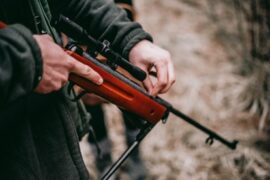
How To Prepare Your Hunting Firearms
The Spring hunting season is finally getting closer—to make sure you make the most of this Spring, it is important to prevent any blindsides. Preparation and practice are two keys to your success in the coming months; they allow you to sharpen your skills and end up saving time and money in the long run.
The preparation process starts at the end of your hunting season. Firstly, when your gun is not in use, it should be stored somewhere safe and secure; namely, a gun cabinet with a lock. Wherever the gun case is located, it should be out of reach for children. The firearm should be unloaded, and ammunition should be kept in a separate, secure location from the firearm. Not only is storage important for safety purposes, it also prevents environmental factors from affecting your supplies. An improperly-stored firearm is at risk of jamming due to moisture in the air.
To prepare your hunting firearms, whether it is after a long winter, or they have been in continual use, there are several things that need to be completed in order to get your firearm in top shape for the season ahead. This article will include a number of tips and tricks everyone can use in preparation for hunting season.
Check the Sights on Your Firearm
It doesn’t matter when you last used your gun; you always need to check the sights before use. Even a minor movement during storage can cause the sights to move, taking the weapon out of scope. Depending on your gun and what you are hunting, the sights can be adjusted in a range of different ways. Rifles are usually zeroed in between 1.5 and 3 inches per 100 yards. If you are hunting whitetail, most hunters prefer a 100-yard zero, but if it is elk or deer, it may be preferable to use a 200-yard zero.
Select The Correct Choke
When preparing your gun for hunting, you need to select the correct choke depending on what it is you are hunting. An improved cylinder is the best for rabbits, quails and other small game; a modified choke can be used for longer ranges perfect for hunting ducks and geese, and a full choke is used for ranges forty feet or longer. Ensuring you have the correct choke installed on your gun will help you to get the best shot and hopefully have a successful trip.
Clean Your Firearm
Before you start to clean your gun, ensure it is unloaded as no one wants to accidentally discharge any weapon as it may cause injuries or death. If you have time, take the gun apart, especially if it has been a while since you last cleaned it.
There is a reason why all soldiers are obsessive with how clean their gun is—firearms are more reliable and accurate in this manner. Residue from the previous hunting session can get into every part of the gun, leaving a layer of dirt and grime. Clean the barrel and move parts until they are shiny and smooth, using a utility brush or cleaning swabs. Remove any loose particles that may be found within the slide, frame or chamber. Then, coat all the components in a protective oil; this will allow the firearm to work optimally. These surfaces include metal-on-metal, rails, guides, and the outside surface of the barrel.
Ensure that the action is cleaned thoroughly, as this is where jamming or misfire occurs most frequently. By cleaning it and then adding a small amount of lubricant, it should prevent any issues from happening and extend the life of your gun. To ensure it is working efficiently, fire a small number of rounds in a safe area, like a shooting range. Check for any irregularities, and inspect each piece as you reassemble the firearm. Note damage, excessive wear or movement. Occasional dents and scratches happen, but other damage can lead to potential safety concerns.
Protect Your Firearm
One of a hunter’s greatest problems that they may face is rust. Rust can cause significant problems in a gun or even decommission it. To ensure this does not happen, keep the action of the gun well protected. The end of the barrel should be covered with electrical tape to protect it from any moisture and general wear and tear. Avoid using duct tape on any part of your gun as it leaves a residue, but more importantly, it can impact the bullet’s path when fired.
If the firearm is exposed to the elements, it is best to disassemble and re-clean parts as needed.
Visually Inspect The Whole Firearm
Before going on your hunting session or trip, visually inspect every part of your firearm, including the stock and sling mountings. By doing this, you are confident that there are no problems that you will encounter while out on the field. Even a tiny crack in the stock can lead to other issues. The last thing you want is while out having a good time with your friends; your hunting session is cut short due to a malfunctioning or broken firearm. While you check your gun, check your gun case, as this protects the firearm while you are not using it.
Use High-Quality Ammunition
Hunting is a worthwhile hobby that offers satisfaction, but it can be expensive to start from scratch. One of the places that it isn’t a good idea to scrimp on is the ammunition for the firearm. Using high-quality bullets will give you the results you are looking for when on the hunt.
Also, it is essential to have a range of ammunition so that you can use the correct bullets for the correct game you are hunting. For deer or antelope, a bullet that holds together on impact but then rapidly expands is suitable. But this bullet would not be ideal for a larger animal like a moose. For this, a bullet with a thicker jacket and a bonded core will penetrate the animal better for a simple and clean kill.
Practice Shooting Before Hunting Season
Once you have your firearm sighted in, it is always a good idea to complete some practice shots before actually going on a hunting trip. Experts state that, to maximize your hunting preparation, you should have at least six sessions in a shooting range before the hunting season starts. This practice ensures that no one is rusty when they are in the wild looking for game or other animals. At least, the firearm that you are using to go hunting should be fired a minimum of fifty times. New guns should not be brought on a hunt, but if you have no other choice, then a high amount of practice should be completed before the trip.
Practicing with your gun allows you to become reacquainted with it and its fine details. Practicing also ensures that the firearm is working optimally before the season begins.
By using these tips and tricks to prepare your firearm before the hunting season, you will be prepared and confident, and your first hunt should go ahead without a hitch. Hunting should be an enjoyable and safe activity for everyone involved, and preparation can help hone your gunsmithing skills.
If you need any other information on gun safety or starting gunsmithing as a hobby, then MGS Trade School has everything you need to begin your journey.
By: Ryan Clancy, Engineering HQ


